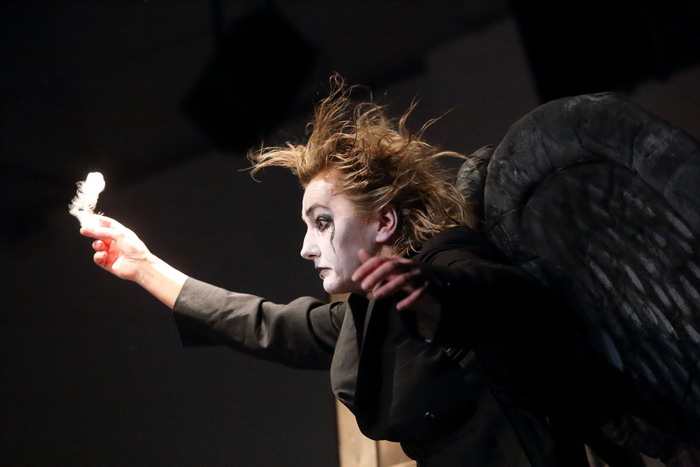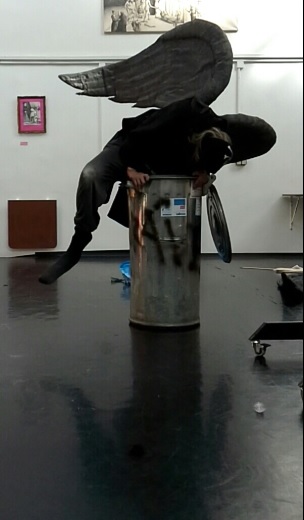Heavenly Clownery Angel-y
 Premiere of the clown-mime production Angel-y by Vanda Hybnerová and Lucia Kašiarová took place already during the festival 4 +4 Days in Motion in the fall of the last year. However, the currently performed version is markedly different – for one thing, the role of the injured Lucia Kašiarová has been taken over by Tereza Ondrová, for another, the original motion dialogue between an actress and a dancer has been dramaturgically refined. Furthermore, the new ending is enhanced by a static performance by Lucia Kašiarová, whose presence on the stage thus affirms the main idea of the production. Stage direction has been shared between both performers. Very simple stage design by Michal Kábele and Hynek Dřízhal works only with props – ambulatory doors, a ladder, garbage cans and small artifacts, such as squeaky toys, a sword, a bow and arrows. Its austerity is offset by dazzling, visually spectacular costumes, the visual effect of which is further enhanced by an exceptionally creative clown makeup. Angel-y is purely a visual-movement piece, the poetics of which oscillates between the genres of physical poetry and absurd drama. Due to the employment of fine clownish features it could be also described as a poetic clownery, heavily imbued with ideas of existentialism.
Premiere of the clown-mime production Angel-y by Vanda Hybnerová and Lucia Kašiarová took place already during the festival 4 +4 Days in Motion in the fall of the last year. However, the currently performed version is markedly different – for one thing, the role of the injured Lucia Kašiarová has been taken over by Tereza Ondrová, for another, the original motion dialogue between an actress and a dancer has been dramaturgically refined. Furthermore, the new ending is enhanced by a static performance by Lucia Kašiarová, whose presence on the stage thus affirms the main idea of the production. Stage direction has been shared between both performers. Very simple stage design by Michal Kábele and Hynek Dřízhal works only with props – ambulatory doors, a ladder, garbage cans and small artifacts, such as squeaky toys, a sword, a bow and arrows. Its austerity is offset by dazzling, visually spectacular costumes, the visual effect of which is further enhanced by an exceptionally creative clown makeup. Angel-y is purely a visual-movement piece, the poetics of which oscillates between the genres of physical poetry and absurd drama. Due to the employment of fine clownish features it could be also described as a poetic clownery, heavily imbued with ideas of existentialism.Two strange black-feathered beings with faces gently dusted with white and a strong, also black, but only outlined clown makeup appear on the stage. They are dressed in tailcoats, trousers and huge black boots, on their backs there are realistic looking wings they can move with in different ways. As for their appearance, it is somewhere between Goya's ghosts, apparitions from Byzantine frescoes and characters from a contemporary sci-fi movie. It is morning, crowing wakes one of them, which is followed by a moment of morning sleepiness and waking up and a music theme can be heard: the voice from above calls the angels to service at the gates of Heaven. One of the angels has a sword, the other has a bow and arrows. They stand on garbage cans and welcome imaginary visitors. But is it really gates of Heaven? And are they really angels? A pass-through, swinging doors in a movable, metal frame leads nowhere. Moreover, nobody else comes, even though the voice from above calls again and again. The angels, at first enthusiastically carrying out their mission, gradually sink into depression. They while away the time making little jokes, but boredom makes them leave the service; they choose their own existence. This brings about several both poetic and dramatic scenes: they gain height racing their garbage cans, enjoy the sensation of flight and eventually land. But they also have their ideals and desires. From the top of the assembled garbage cans they observe the world, but the flowing tenderness of white feathers repeatedly slips through their fingers; this is followed by moments of injuries and recoveries by drops of light and there is a time for a game once again: shooting with a bow, which turns from amusement to a fatal hit; the wounded angel is deprived of his wings and dies, the other can not cope with the feeling of guilt. However, he fails to fix the rope in his hands anywhere, the rope transforms into a lasso, which surprisingly draws another victim.
 Dramaturgically refined dialogue between Vanda Hybnerová and Tereza Ondrová is from the very beginning a sequence of charmingly grotesque scenes in which both performers employ their movement creativity, personal charm and wit. Either of them has created a distinctive type of character, in behaviour and physical appearance quite different from each other: Vanda Hybnerová‘s sweet feminine appearance somewhat made her distort her face with a grimace and interweave her acting with little follies and flowing movements of the whole body. The actress famous for her qualities in drama and her performances in a number of mime productions is – at first sight – a bit more active than her partner, although both perform certain sequences almost synchronously. Apart from her masterfully controlled movements Vanda Hybnerová works a lot with facial expressions, whether clown-like and grotesque, letting her comic go as far as a portrayal of psychological shock, or a tragic dismay at the end of the play. In contrast, tall and slender Tereza Ondrová probably drew inspiration from the intellectual wit of Boleslav Polívka’s Clown, long, graceful movement of her limbs does not require too many gestures, her extremely plastic arms and a subtle ironic sneer on her face are enough to give the audiences an idea of the production’s storyline. Especially at the moment of the fatal hit and the subsequent death of her black angel she showed a surprisingly outstanding dramatic talent, which – contrary to her earlier (also lovely) humorous acts – in the mimical resonation throughout the whole body had an authentically tragic effect.
Dramaturgically refined dialogue between Vanda Hybnerová and Tereza Ondrová is from the very beginning a sequence of charmingly grotesque scenes in which both performers employ their movement creativity, personal charm and wit. Either of them has created a distinctive type of character, in behaviour and physical appearance quite different from each other: Vanda Hybnerová‘s sweet feminine appearance somewhat made her distort her face with a grimace and interweave her acting with little follies and flowing movements of the whole body. The actress famous for her qualities in drama and her performances in a number of mime productions is – at first sight – a bit more active than her partner, although both perform certain sequences almost synchronously. Apart from her masterfully controlled movements Vanda Hybnerová works a lot with facial expressions, whether clown-like and grotesque, letting her comic go as far as a portrayal of psychological shock, or a tragic dismay at the end of the play. In contrast, tall and slender Tereza Ondrová probably drew inspiration from the intellectual wit of Boleslav Polívka’s Clown, long, graceful movement of her limbs does not require too many gestures, her extremely plastic arms and a subtle ironic sneer on her face are enough to give the audiences an idea of the production’s storyline. Especially at the moment of the fatal hit and the subsequent death of her black angel she showed a surprisingly outstanding dramatic talent, which – contrary to her earlier (also lovely) humorous acts – in the mimical resonation throughout the whole body had an authentically tragic effect. Due to both intelligent actresses-dancers the seemingly light-hearted, fairy tale-like storyline turned into an absurd grotesque of human existence. Anyway, the sheer delight of an imaginative habitus of the piece, the witty transformation of various visual art and literary motifs into new poetic meanings and the energy both performers put into building up their characters on the stage grant the production big success with audiences.
The production Angel-y undoubtedly ranks among several pieces of mime theatre, which have recently vindicated the meaning and qualities of the genre. In this context, special thanks go to the management of Studio Alta – especially Lucia Kašiarová – who once again proved their artistic tolerance and the ability to accept a wide range of creative ideas.
Written from a performance on March 21st, 2014, Studio ALTA.
Angel-y
Stage direction: Lucia Kašiarová and Vanda Hybnerová
Divine inspiration: Boris Hybner
Angelic stage design: Michal Kábele and Hynek Dřízhal
Heavenly lighting design: Lukáš Benda
Premiere: October 18th, 2013


